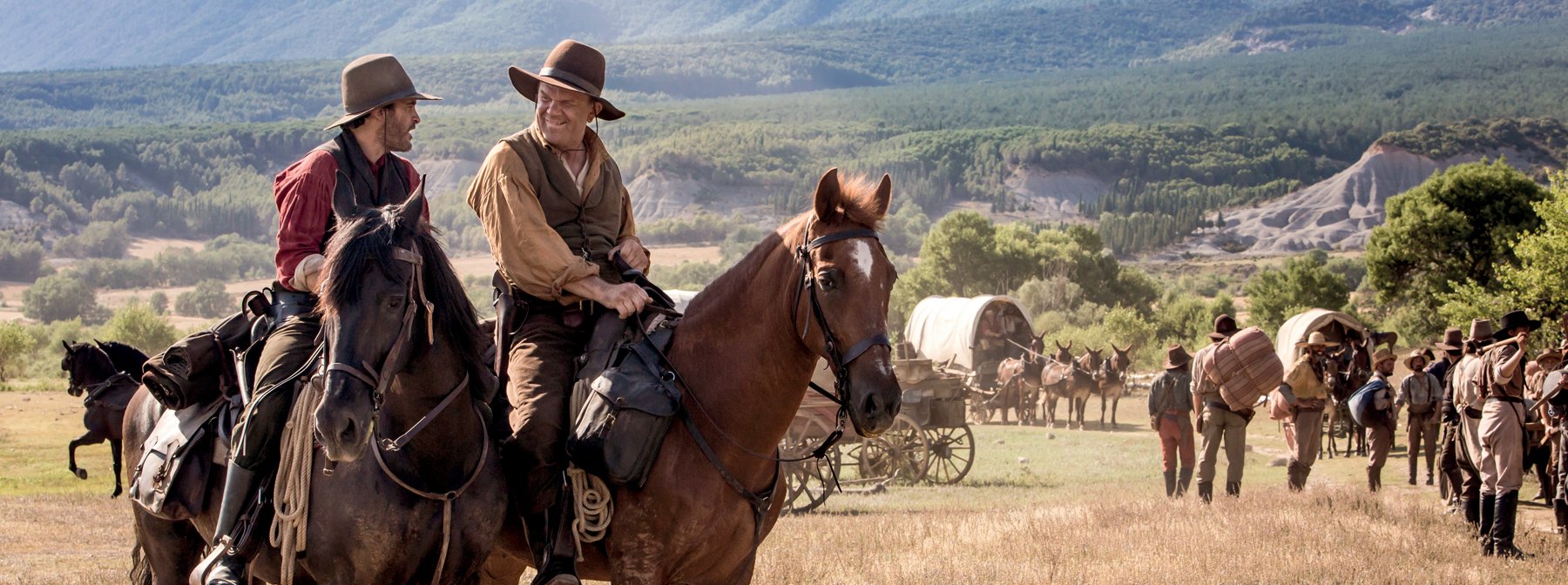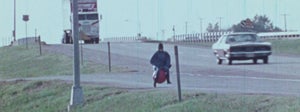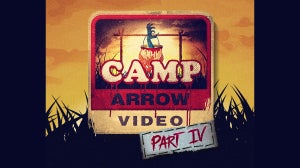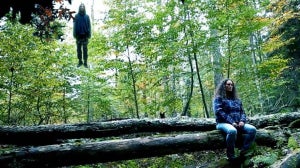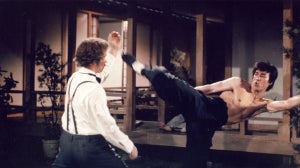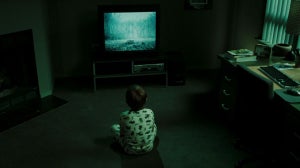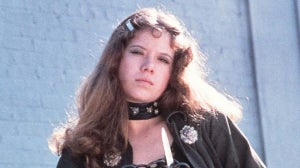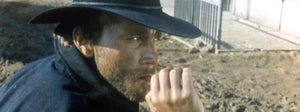
Clint Eastwood once observed that the Western, much like jazz, could be considered one of the few truly American art forms. And while it's certainly true that he and a number of other US directors and stars have helped make the genre a cinematic mainstay over the decades, we shouldn't overlook the huge contributions made by artists of other nationalities. (Let's not forget that Eastwood himself might never have become a star were it not for his early roles in Sergio Leone's trilogy of Spaghetti Westerns.)
One notable recent example of a non-American tackling the form would be French director Jacques Audiard's award-winning 2018 Western The Sisters Brothers, available via Arrow Video. So, to tie in with that release, we thought we'd take a look at a number of other estimable 21st century Westerns. While the genre may not enjoy the huge popularity with general audiences it once did, it's also fair to say that rumours of its demise have been greatly exaggerated, as evinced by the many excellent contemporary films included on this list (and several more that aren't – I've tried to offer up a mix of better-known titles with some more obscure picks, meaning that some truly wonderful latter-day Westerns failed to make the cut).
While compiling this list, it also occurred to me that the films separated quite neatly into linked pairs, so I thought it might be interesting to organise them as thematic double-bills – but feel free to watch them in whatever order you wish...
The Homesman (2014) & The Wind (2018)
After Clint Eastwood's Oscar-winning Western swansong Unforgiven (1992), he essentially retired from the genre that first made him a star, leading some critics to wonder whether the Western would survive the loss of its last great icon. But while we possibly may never see Eastwood's like again, a couple of other actor/directors have since taken up the challenge of shepherding the genre into the 21st century. We'll get to the other one shortly, but after having spent several decades as a granite-faced and famously ornery supporting actor, in more recent years Tommy Lee Jones unexpectedly emerged as a Western auteur of real note. His debut feature The Three Burials of Melquiades Estrada (2005) first put him on the map (and is also well worth a watch), but I wanted to single out his underseen followup The Homesman here.
It tells the story of a lonely spinster (Hilary Swank) who embarks on a journey to escort a group of three women, all of whom have been driven mad by the hardships of frontier life, to the safe haven of a small town church back east. Hiring a ne'er-do-well lowlife (played by Jones himself) to accompany her on the mission, what results is an absorbingly eccentric picaresque, by turns blackly comic and unexpectedly tragic. As the ill-matched travelling companions, Swank and Jones share a genuine onscreen chemistry; one can readily imagine that the film might have proved more successful with audiences if it had gone the easy route of romantically pairing them off together by its close. And although Jones certainly makes the most of his plum role as the shiftless loser who gradually undergoes something of a moral awakening, The Homesman also deserves credit for its emphasis on the plight of women in the Old West.
In a genre not always noted for its feminist credentials, The Homesman depicts a grinding, pitiless world where no white-hatted gunslinging male heroes exist. Indeed, most of the men portrayed here are either craven or viciously corrupt, and when faced with such a prospect, it's hardly any wonder that so many of the female characters flee gladly into insanity or even death.
Emma Tammi's The Wind envisages a similarly bleak existence for its own female protagonist (one can easily picture her as one of the women placed under Hilary Swank's care in The Homesman). Lacking even the occasional comedy of Jones's film, The Wind is a particularly unnerving example of a kind of hybrid that seems to have become increasingly common in recent years: the horror Western. In its account of an unstable frontierswoman tormented by jealousy and isolation, not to mention a succession of prairie-dwelling demons (be they real or imagined – Tammi lets the viewer decide), the film is, at heart, a Western cousin to Roman Polanski's seminal psychological horror movie Repulsion (1964).
Again, there is no heroism nor any romantic notions about frontier life to be found here; Tammi makes it clear just what a perpetually hardscrabble undertaking life in the Old West really was, especially if you were a lonely and vulnerable woman. Very often, the Western represents a reassuring myth about notions of freedom and masculinity that America likes to tell itself; in their different ways, The Homesman and The Wind show us something of the dark reality lying behind the myth.
https://www.youtube.com/watch?v=u6uQkoXKGxM
https://www.youtube.com/watch?v=eYb_0Bdsfno
No Country for Old Men (2007) / Hell or High Water (2016)
While the period Western may now be considered passé by many, a number of recent films have attempted to transpose the genre's themes and concerns into the modern day. In a career filled with notable high points (including two other excellent Westerns, True Grit [2010] and The Ballad of Buster Scruggs [2018] ), the Coen brothers' adaptation of Cormac McCarthy's novel No Country for Old Men still stands out as a masterpiece. A mournful elegy for times past, the film follows an increasingly befuddled Texas sheriff (played by Tommy Lee Jones, in his second appearance on this list) as he attempts to save an in-over-his head cowboy (Josh Brolin) from certain death at the hands of Javier Bardem's implacably sociopathic assassin.
The Coens understand that Jones is a relic from a bygone age, and his Old West values, however noble, have no place in a lawless world where the hero thinks nothing of going on the lam with a briefcase full of stolen drug money, and the villain represents a breed of purely nihilistic evil that is almost unknowable in its sheer malevolence. As an old colleague of the sheriff warns him towards the end of the movie, “You can't stop what's coming.”
In Hell or High Water (directed by David Mackenzie, although the film's true auteur is probably writer Taylor Sheridan, who went on to create the hit TV Western Yellowstone), Jeff Bridges essays another lawman out of time: a retirement-age Texas Ranger who is disconsolately watching a world he once understood gradually slip away from him.
While the film possess a similarly elegiac tone to No Country for Old Men, it differs inasmuch as the crimes of the two outlaw bank robbers being pursued by Bridges (Chris Pine and Ben Foster) do not represent the almost abstract breed of cosmic malignity personified by Bardem in the earlier film, but are instead an entirely understandable attempt to fight back against the sort of banal everyday evil committed by America's financial institutions. There are no true heroes or villains in Hell or High Water; only desperate, damaged people trying to avoid being swept away by the unscrupulous forces of so-called progress.
https://www.youtube.com/watch?v=38A__WT3-o0
https://www.youtube.com/watch?v=JQoqsKoJVDw
Bone Tomahawk (2015) / Brimstone (2018)
Earlier on, I mentioned the odd prevalence of horror-themed westerns in recent years; well, just to prove the point, here are two more. In the course of his relatively brief film career, director S. Craig Zahler has proven to be a somewhat divisive figure; his baggily verbose screenplays and perverse delight in upending genre expectations mark him out as a post-Tarantino auteur, although his penchant for brutally explicit violence outdoes even that of the Pulp Fiction director's.
Nowhere is that better demonstrated than in his debut feature Bone Tomahawk, which features moments of gory mutilation so unflinching that they provoked audible gasps amongst the preview audience I initially saw it with. In the broad strokes of its plot, Bone Tomahawk could easily be seen to represent an old-fashioned cowboys & Indians narrative, but no doubt aware that casting Native American tribespeople as his villains would no longer fly with most modern-day audiences, Zahler instead makes his marauding tribe a group of mutated troglodytes; a crafty narrative dodge that ultimately situates the film within realms of storybook myth similar to those occupied by many classic Hollywood Westerns (although one can't readily imagine old-timers John Ford or Howard Hawks approving of the younger director's gleefully bloody excesses).
Zahler never bothers to explain the provenance of his mutant tribe; in Martin Koolhoven's Brimstone, we are left similarly in the dark as to whether Guy Pearce's nameless and quasi-demonic preacher truly has, as he claims, literally clawed his way back from Hell. Brimstone's digressive structure, divided into separate chapters that skip back and forth in time, also mark it as a post-Tarantino work, but it is a far more solemn film than Zahler's. (Albeit similarly divisive; one unimpressed review called it “dimwitted, amoral exploitation.”)
At its core, the film is essentially one drawn-out chase, detailing Pearce's obsessive years-long pursuit of a young woman (played by Dakota Fanning). During the course of their ongoing struggle, we gradually come to learn the truth about the history they share together, but whereas Pearce's character remains a malevolent cypher, defined only by his craving for Old Testament-style vengeance, one of the most remarkable things about the film is the way Fanning's fierce performance guides us through a series of thumbnail sketches detailing the lives of women in the Old West.
Over the course of many years and several different identities, she moves from virginal daughter to prostitute to dutiful wife and mother to frontier businesswoman; her desire to achieve a better life forever being dogged by Pearce's unholy determination to see her dragged back to Hell alongside him. An unlikely act of climactic escapology is Brimstone's most glaring flaw, but otherwise it is an impressively acted and bracingly bleak depiction of the American West as Purgatory, and deserves to be more widely seen.
https://www.youtube.com/watch?v=0ZbwtHi-KSE
https://www.youtube.com/watch?v=_oc0gzklT10
Let Him Go (2020) / God's Country (2022)
The two most recent films on this list, and two more modern-day Westerns (after a fashion: Let Him Go is set in the early 1960s). Revenge narratives are a common enough trope in the genre, but as these two films show, meeting violence with yet more violence is never the simple solution some classic older Westerns would like to have us believe. Kevin Costner has been firmly identified with the Western ever since he directed and starred in the Oscar-winning Dances With Wolves (1990). (Since then, he has gone on to helm the impressive Open Range [2003] and star in Taylor Sheridan's aforementioned Yellowstone.)
In Thomas Bezucha's Let Him Go, he plays a retired lawman who sets out with his wife (Diane Lane) to try and rescue their beloved grandson from the clutches of his adoptive family. The family in question turn out to be a tribe of leering criminal lowlifes that are strongly reminiscent of the sort of psychotically inbred families often found in the Westerns of Sam Peckinpah, and much like a Peckinpah movie, the couple's confrontation with the clan quickly escalates to gruelling violence and murder. What is particularly interesting about Let Him Go is its depiction of the Western family as matriarchy; while you might expect Costner's by-the-book lawman to be the gun-toting hero of a more conventional film, here he is constantly pleading restraint to his grieving wife, to little avail. It is her festering anger (as well of that of her rival counterpart, played by Lesley Manville) that brings about the tragic stand-off that closes the film.
If anything, Julian Higgins's God's Country is even grimmer in its depiction of a country riven by the deep divisions between those people who are stubbornly trying to hold onto an older way of life, and those who can only see such efforts as attempts to preserve an oppressive status quo. Thandiwe Newton plays a black college professor who moves to a small Montana community and quickly becomes embroiled in an argument with two hunters she catches trespassing on her property. Because neither party will willingly compromise or back down, what should be a relatively trivial matter soon spirals inexorably out of control.
What is most admirable about God's Country is its even-handed portrayal of the two warring sides. Despite his undoubted hostility to outsiders, one of the hunters is shown to be an essentially decent, if painfully old-fashioned, man; likewise, whereas it would have been easy to simplistically paint Newton's character as a noble crusader, Higgins takes great care to show us that, although her underlying rage at the inequities of society may well be justified, her blind refusal to negotiate or compromise with the opposing side can only serve to bring about disaster.
America is a land founded on violence and genocide, and while many earlier Westerns attempted to portray that slaughter as a legitimate means of bringing order to an uncivilised country, what films like Let Him Go and God's Country demonstrate is that the corrosive stain of such violence can never be wiped away by so-called civilisation. Unless the root causes of it are addressed, eventually it will always come spilling up through the cracks, ready to infect us all anew.
https://www.youtube.com/watch?v=bE8pwEF-3TI
https://www.youtube.com/watch?v=92kQD4fc0a0

